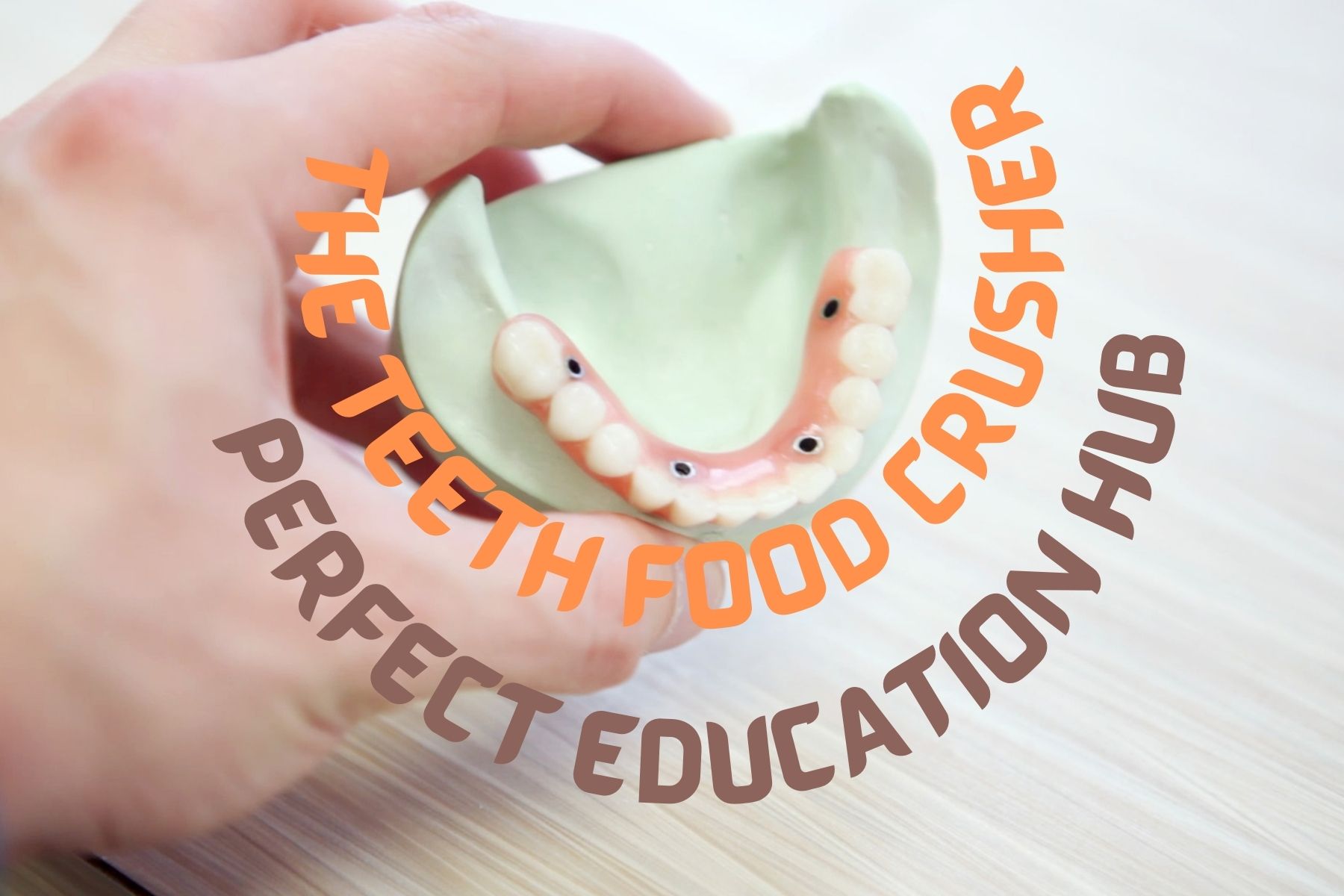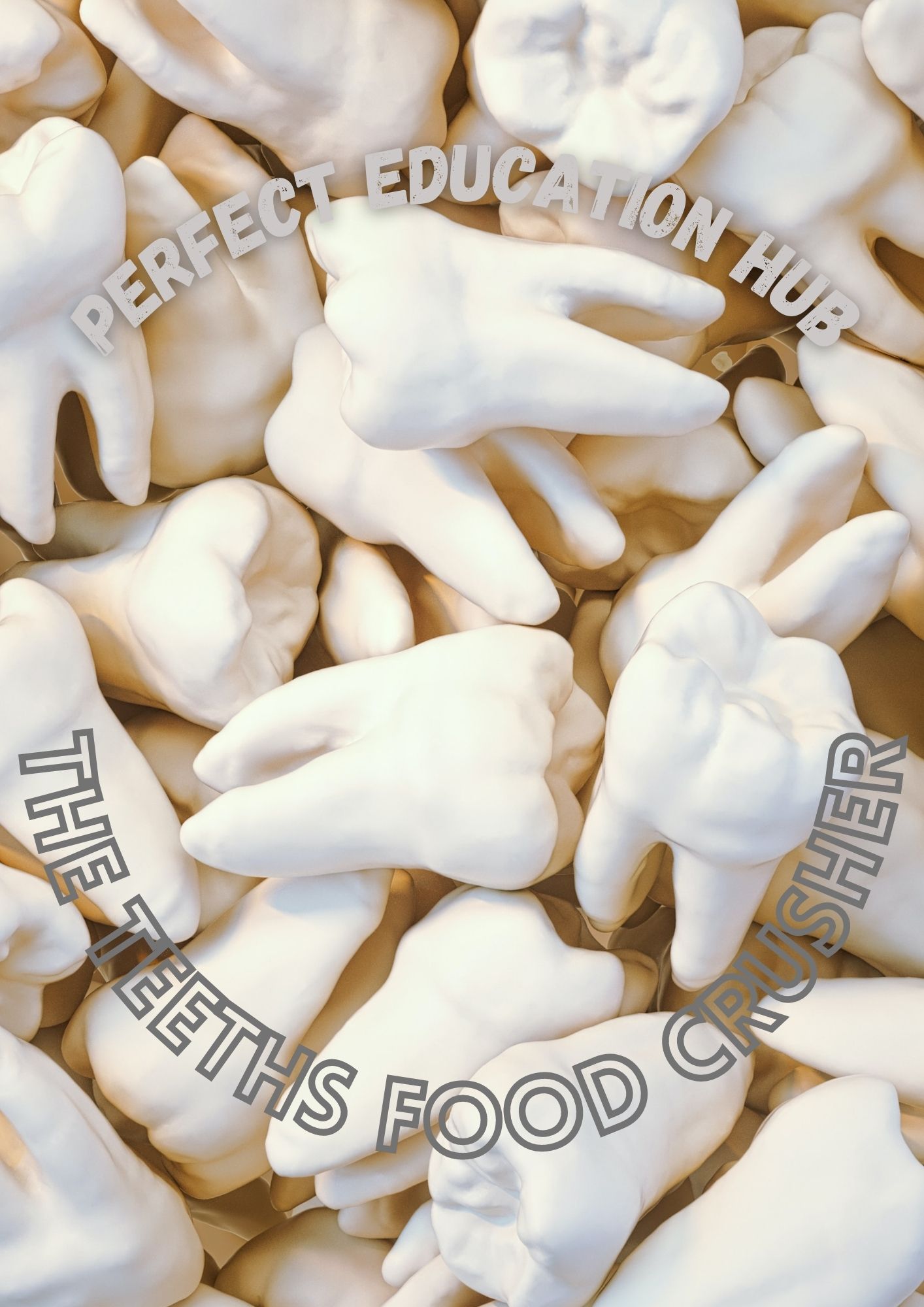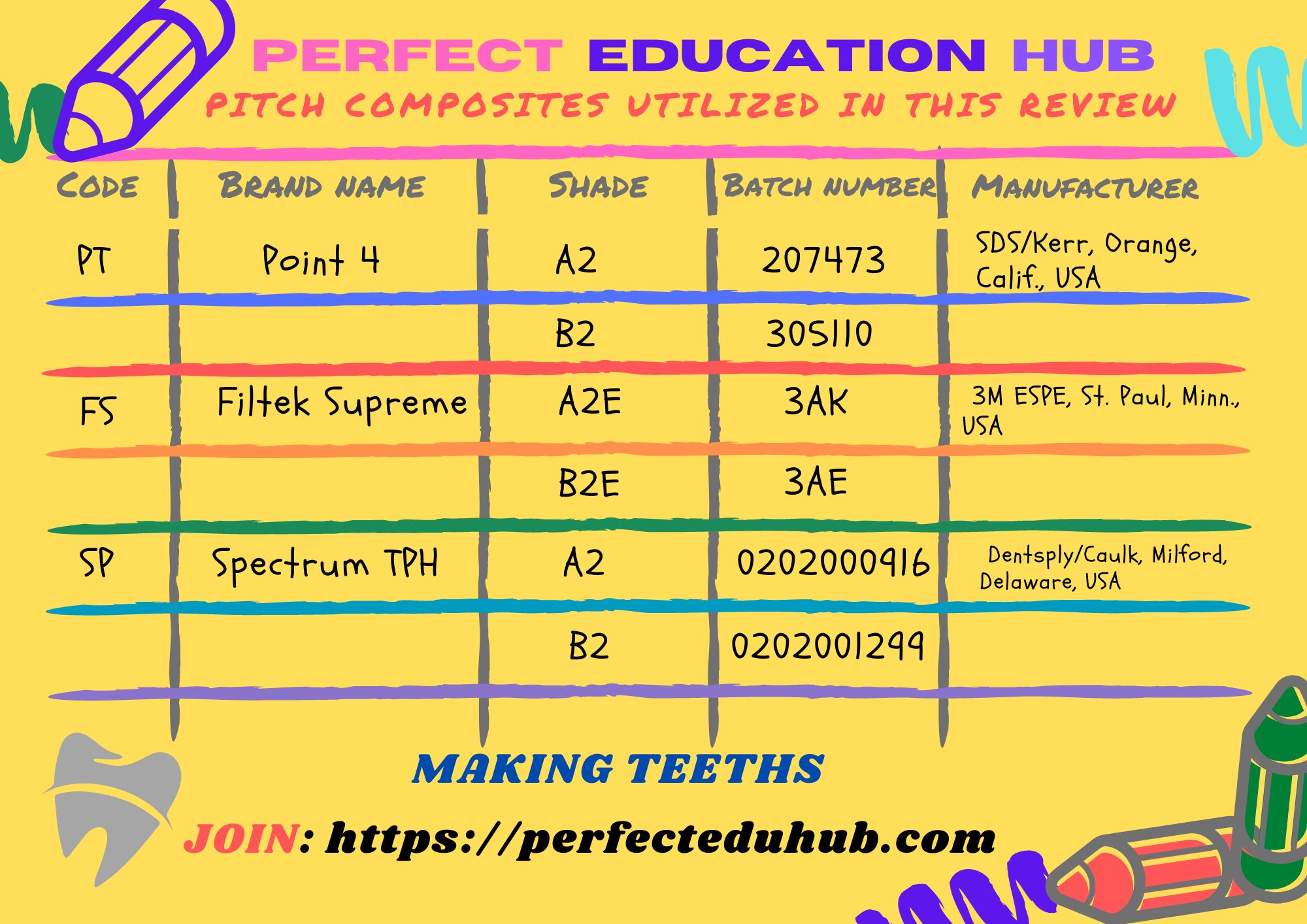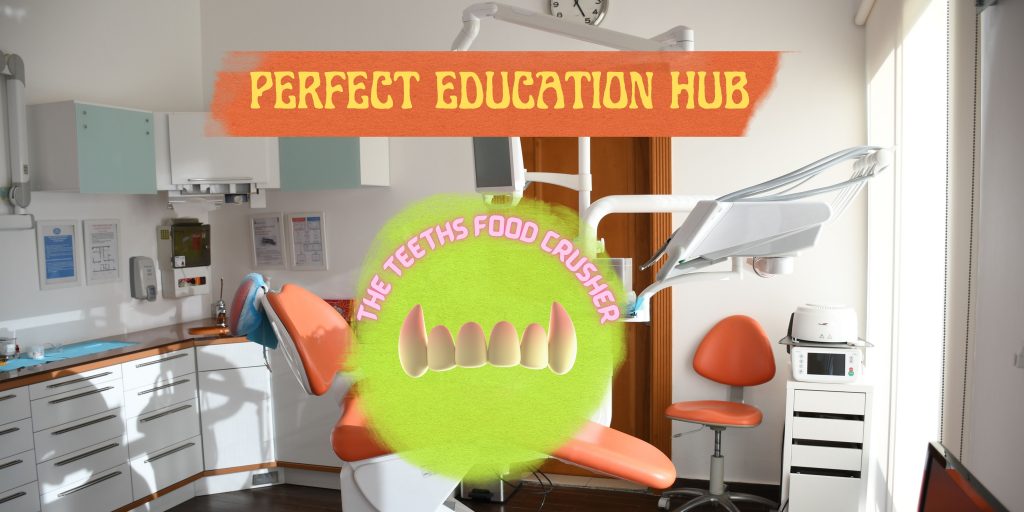The Teeths Food Crusher .?
Teeths any of the hard, safe designs happening on the jaws and in or around the mouth and pharynx areas of vertebrates. Teeths are utilized for getting and chewing food, for guard, and for other specific purposes.

The teeths of vertebrates address the changed relatives of hard dermal (skin) plates that reinforced tribal fishes. A teeths comprises of a (crown) and at least one (roots). The (crown) is the utilitarian part that is noticeable over the (gum). The (root) is the concealed piece that backings and affixes the teeths in the (jawbone). The root is joined to the tooth bearing bone the alveolar cycles of the (jaws) by a stringy tendon called the periodontal tendon or layer. The “neck” of the root is embraced by the plump gum tissue (a particular area of connective tissue covered with mucous film that lines the mouth hole). The state of the crown and root shift among various teeths and among various types of creatures.
HOW TEETHS ARE MADE.?
All evident teeths have similar general construction and comprise of three layers. In warm blooded creatures an external layer of finish, which is entirely inorganic and is the hardest tissue in the body, covers part or all of the (crown) of the teeths. The center layer of the teeths is made out of dentine, which is less hard than finish and comparable in arrangement to bone. The dentine shapes the primary mass, or center, of every teeths and broadens practically the whole length of the teeths, being covered by finish on the crown segment and by (cementum) on the roots. Dentine is fed by the mash, which is the deepest piece of the teeths. The mash comprises of cells, little veins, and a nerve and possesses a depression situated in the focal point of the teeths. The mash channel is long and restricted with an extension, called the (mash chamber), in the coronal end. The mash trench broadens practically the entire length of the teeths and speaks with the body’s overall nourishing and sensory systems through the apical foramina (openings) toward the finish of the (roots). Underneath the gum line broadens the base of the teeths, which is covered unquestionably somewhat by (cementum). The last option is comparable in design to bone however is less hard than dentine. (Cementum) manages the cost of a dainty covering to the root and fills in as a vehicle for connection of the filaments that hold the teeths to the encompassing tissue (periodontal film). Gum is joined to the contiguous alveolar bone and to the cementum of every teeths by fiber packs.

HOW TO MAKE TEETHS BRIGHTENING SUBSTANCE.?
The utilization of tooth brightening specialists to work on the presence of regular dentition has turned into a famous system. Tooth brightening specialists actually brighten the tooth. Contemporary specialists depend essentially on (hydrogen peroxide) or its mixtures, for example, (carbamide peroxide) or (sodium perborate), and these are in many cases utilized in blend with an actuating specialist like intensity or light.
Tooth brightening is accepted to happen through oxidation of natural substances in tooth by oxide free extremists that are created from the tooth brightening specialist. The oxidation cycle changes the synthetic design of associating natural substances of tooth, which brings about variety change.
The viability of tooth brightening strips and film on the variety improvement of normal dentition has been accounted for in a clinical report. There were massive changes in (CIE L) and (CIE b) upsides of tooth subsequent to fading with tooth brightening strip. An examination on the impacts of low centralizations of home fading specialists on the attributes of tooth surface showed no massive changes in veneer, dentin, or the dentinoenamel intersection. Be that as it may, in an assessment of exceptionally thought (carbamide peroxide) for office blanching, a few changes were tracked down in the construction of polish.
Pitch composite is an exceptionally well known stylish helpful material of which the variety coordinating with the tooth has been of incredible worry for specialists and patients.Highly concentrated office blanching frameworks impacted the shade of tar composite, however low convergences of home fading frameworks didn’t. In a concentrate on a superficial level harshness (Ra) of supportive materials in the wake of blanching, there was no huge change in porcelain, a slight change in gum composite, and massive change in glass ionomer. Then again, there was no massive change in (Ra) upsides of sap composite after in office fading. In past examinations, there were shifted levels of progress in variety and surface harshness of gum composites subsequent to fading. There have been different deals with the brightening adequacy of as of late presented film and strip type tooths brightening specialists in normal dentition however barely any on tasteful helpful materials. As of late, a nanofilled pitch composite with essential filler size of (5-20nm) was presented. Its surface properties might be unique in relation to those of crossover composites.The reason for this study was to assess the impacts of two sorts of home blanching frameworks on the progressions on variety and surface unpleasantness of (microhybrid) and (nanofilled) tar composites.

Materials And Techniques:
Gum composites and brightening frameworks three brands of pitch composites of (A2) and (B2) conceals were examined. The shade assignments of (A2) and (B2) are taken from the(Vita lumin vacuum conceal) guide (VITA).
One nanofilled tar composite was coded as (FS). The fillers were a blend of totaled (zirconia/silica) bunch fillers with essential molecule size of (5-20nm) and a (nonagglomerated/nano total 20nm) silica filler. The filler stacking was (78.5 wt/%). (PT) contained roughly (75 wt./%) (57 vol/%) inorganic filler with a typical molecule size of (0.4mm) and (SP) contained (77 wt./%) of microfilter (normal 1mm,maximum 5mm) and submicron filler (0.01-0.04mm). Two sorts of tooth brightening frameworks for home dying were applied. There were a few distinctions in application conventions for the two frameworks, however both made dainty movies on the substance surface. The strips acted similarly as contributors of this film. Planning of composite examples (10mm) in breadth and (1mm) thick were made with a (politer fluoroethylene form). Pitch composite was stuffed into the form, with the upper and lower surfaces covered with acetic acid derivation framework strips. The examples were light restored for (40s) by separating
the examples into three regions each with a Range (800 light restoring unit) (Dentsply/Caulk, Milford, Del. USA). with a power setting of (400mW/cm2), and the result of the restoring light was checked with a radiometer (SDS/Kerr, Orange,Calif.USA).
The examples were scoured against a sheet of wet silicon carbide paper of (1500 grit) for (50 strokes) of (15cm) long to eliminate the oxygen hindrance layer and sap rich layer from the surface.
All examples were put away in refined water at (37C) for (24h) and cleaned in refined water in a ultrasonic cleaner for (60min).(Twenty five) examples were made for every material and shade. The examples were partitioned into (five) gatherings of (five) each, including the benchmark group. Brightening technique film type brightening specialist was just applied on the smudge dried surface of composite example. As per the makers proposals, the functioning time of this kind is during rest around evening time. By and large, a great many people rest roughly (8h) thusly, the functioning time of this sort was assessed at 8h. Strip type brightening specialist was ready in (10mm) squares. As indicated by the makers suggestions, its functioning time is (30min) two times every day. It is suggested that all the brightening frameworks need (fourteen days) of this routine for the greatest brightening impact.
Every one of the examples were put away in a (37C), (100 percent) relative mugginess chamber during the brightening system. In the wake of eliminating the fading specialist after every application (8h or 30min), the examples were washed in refined water for (30s). These methods were rehashed once per day for the film type and two times per day for the strip type. The control examples were held in the chamber under similar circumstances during the (fourteen days) time span however with practically no treatment.
Surface Harshness Estimation:
Surface harshness (Ra) was estimated with a Surtronic (3P) surface profilometer (Taylor Hobson, Leicester, Britain).
For every example, five estimations were made, with cutoff worth of (0.8mm) and estimating length of (3mm). Preceding estimating, the profilometer was aligned against a reference block (Ra=6.07m). The estimations were made when the dying strategies.
Measurable Investigation:
Contrasts in variety change and (Ra) values brought about by the brightening frameworks were broke down by examination of difference and Scheffe’s various reach test with (SPSS form 11.0) programming (SPSS, Chicago, Sick., USA) (P=0.01). Contrasts in (Ra) values previously and in the wake of fading were contrasted and test (P=0.01).
Results:
There was no amazing contrast in the progressions of endlessly variety arranges in composites.
TEETHS DISEASE?
(Charcot Marie Tooth) illness (CMT) is the most well known inherited neuromuscular jumble, with a commonness assessed at up to (40) people in each (100000), comparing to (200000) cases in the European Association. Concerning numerous different sicknesses, patients with (CMT) frequently have inquiries regarding determination, forecast, and therapy. For most patients with (CMT),
questions in regards to conclusion can be replied, as around (70%) of patients can now get an exact subatomic hereditary finding. No less than (25) qualities have so far been distinguished to be related with (CMT), and the indicative cycle has become muddled and should understand a legitimate succession of examinations. Tragically, there are as yet couple of replies to the inquiries regarding visualization and treatment.

Dealing With Teeths .?
It is vital to take great consideration of your teeths when you have diabetes. Did you had any idea that individuals with diabetes are bound to dislike their teeths and gums? Fortunately you can do whatever it may take to assist with keeping your teeth sound.
1. Brush with a delicate seethed toothbrush no less than two times each day, utilizing toothpaste with fluoride.
2. Visit a dental specialist in the event that you assume you have gum sickness.
3. Limit food and beverages that are high in sugar.
4. Check your mouth for red and enlarged gums, draining gums, free teeths, an adjustment of how your nibble feels, or terrible breath.
5. Keep your glucose at a solid level.
What Are The Indications Of Gum Illness?
1. Red, enlarged, or draining gums.
2. Gums pulling away from teeths.
3. Awful breath.
4. Free teeths or change in nibble or tooth position.
5. Injuries on the gums.

nice